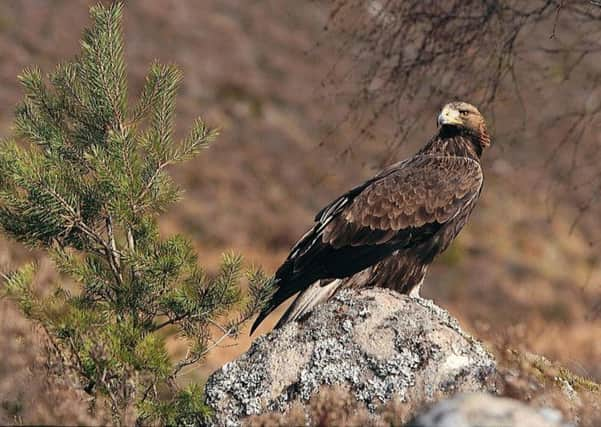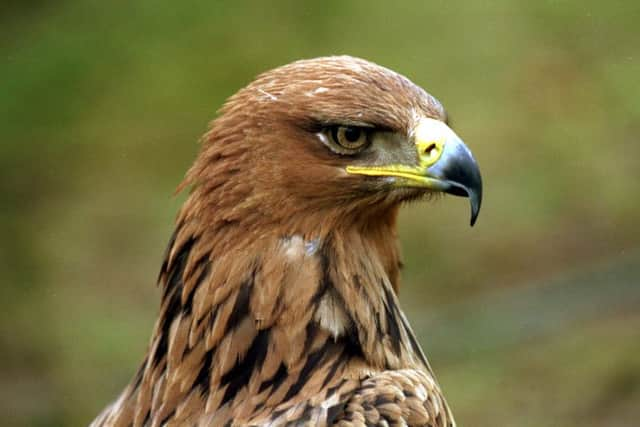New national survey of golden eagle numbers begins


The six-month study will be the first official count of golden eagles since 2003 and the fourth since records began.
It is aimed at assessing how populations are faring after serious declines linked to pesticides in the 1960s.
FOLLOW US


SCOTSMAN TABLET AND MOBILE APPS
Advertisement
Hide AdAdvertisement
Hide AdThe last count identified 442 breeding pairs, a rise of 20 since the previous poll a decade earlier.
Widespread persecution led to the disappearance of golden eagles from England and Wales by the middle of the 19th century.
Britain’s remaining population is confined to Scotland, mainly in he west Highlands and islands.
There is also a solitary male in the Lake District.
Long-term monitoring has shown that although the golden eagle population has remained stable in recent years there have been variations in numbers across different areas.
The most recent survey revealed the overall number of breeding pairs had increased by nearly five per cent since 1992.
However, there were declines of 24 per cent and 28 per cent in the north and south central Highlands respectively since the first survey in 1982.
Researchers are now keen to find out whether conservation efforts over the last 12 years have led to an increase in breeding numbers across the country. The survey will cover all current known golden eagle hunting and nesting areas, known as home ranges.
Areas where golden eagles have previously inhabited will also be assessed to check for any signs of their return.
Advertisement
Hide AdAdvertisement
Hide AdThe new count is co-funded by Scottish Natural Heritage (SNH) and the conservation charity RSPB and will involve licensed surveyors from the RSPB and the Scottish Raptor Study Group (SRSG) visiting each possible home range three times.
Initial inspections will search for the birds or signs of their presence, with follow-up visits to check if pairs are breeding and finally to see if they have been successful in producing chicks.
Dr Daniel Hayhow, from the RSPB Centre for Conservation Science, highlighted the need for the research.
“This national survey is really important to the conservation efforts for golden eagles,” he said.
“These birds don’t breed until they are four or five years old, so having accurate numbers of breeding pairs will help us assess how the population is faring at the moment and in the future.”
Part of the surviving population in Scotland suffered sharp declines in the 1960s due to organochlorine pesticides, which caused mass infertility and eggshell thinning.
But although numbers of the majestic birds have slowly recovered, they continue to suffer from a series of challenges.
These include changes in upland management, increasing forestry in some areas and an influx of wind farms.
Advertisement
Hide AdAdvertisement
Hide AdWildlife crime is also a threat, with 17 golden eagles having been illegally killed in Scotland between 2003 and 2013.
Andrew Stevenson, ornithological adviser for SNH, highlighted the importance of collaboration between conservationists, land owners and public bodies to protect the birds.
He said: “Golden eagles face a range of issues. Persecution is a major concern in some areas, but poor-quality habitat with reduced prey is also a worry in parts of the west Highlands.
“Intriguingly, there has been a suggestion in recent years that some pairs have learned to cope with fairly extensive forests, despite it being a factor in some range losses historically.
“The potential risks from renewables have also increased as the industry grows.
“Clearly, the factors affecting the conservation of golden eagles need us all to work together.”
Dr Hayhow added: “Seeing a golden eagle soaring across the sky is a wonderful sight but this should not be a once-in-a-lifetime experience for people.
“Golden eagles were previously found across most of Great Britain, and it is directly because of the actions of people that they are now almost all confined to certain areas of Scotland.
Advertisement
Hide AdAdvertisement
Hide Ad“The information gathered by the previous surveys and historical records allows us to target the areas our team of surveyors will concentrate on for the next six months, and we are really grateful for the support we have from farmers and landowners.
“To gain an accurate picture of golden eagle numbers each home range must be surveyed three times in this period.
“With some birds known to nest as little as 2km apart in the same glen, this will be a very thorough process that will guide our conservation efforts for these birds over the next decade.”
SEE ALSO: